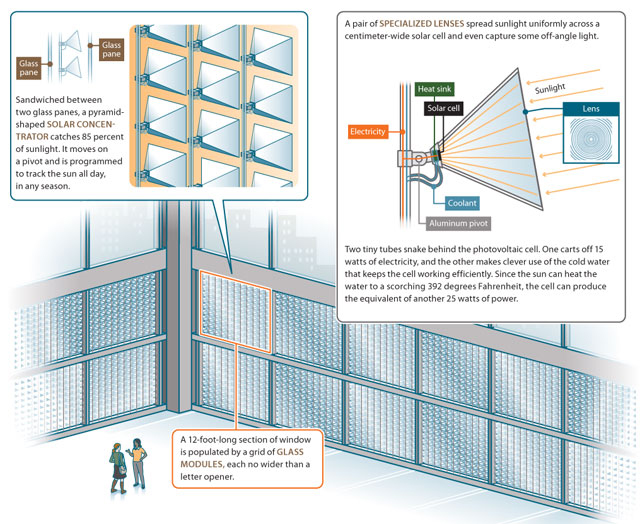sierraclub.org - sierra magazine - march/april 2011 - innovate: windows that generate energy
Skyscrapers have to work hard to protect themselves from the sun. Their vast glassy surfaces absorb so much heat that the air-conditioning pumps all day, sometimes even in winter. And then there's the glare that makes occupants pull the shades and switch on the lights.
One solution may be an integrated, concentrating solar facade—an array of miniature generators that follow the sun like a field of transparent sunflowers. Each lens-and-solar-cell module collects light onto a photovoltaic cell while heating up a trickle of water. A full complement of modules could meet more than 20 percent of a building's energy needs while projecting a sense of urban cool.
Click to see larger image.

Infographic: Brian Kaas
 Jason Vollen
Jason VollenBracing for disappointment, Peter Stark headed into a meeting with another one of those starry-eyed solar people. In the room was architect Anna Dyson, who had an idea for a window system that could harvest 80 percent of the sun's energy—a number some considered theoretically impossible. "Give me an hour," Dyson pleaded.
Stark, then a researcher at Harvard University, had become wary of visionary solar power proposals. Funding for the technology had vaporized when the U.S. government had stopped bankrolling it in the early 1990s. "Too many kooks and not enough science," he says.
Dyson explained how her high-performance design could draw energy not just from light but also from heat, in the form of water. The practicality of her idea persuaded Stark to give concentrated solar another shot. The technology's biggest expenses are the tracking system, which must contend with buffeting winds, and finicky mirrors, which have to be cleaned as often as show dogs. Dyson's design nested the solar concentrators between slices of glass to eliminate dust and wind, inspiring Stark to build a tracking system using hardware found in the average ink-jet printer.
Stark started working with Dyson and soon thereafter pursued his Ph.D. in physics. He is now a professor at Rensselaer Polytechnic Institute's Center for Architecture Science and Ecology, which Dyson directs.
These days, Stark seems to embrace the starry-eyed approach he once eschewed. HeliOptix, the company Stark and Dyson founded, has built a solar facade that hums away at Syracuse University's Center for Excellence in Environmental and Energy Systems. The design is also under consideration for the Fashion Institute of Technology in New York City, a skyscraper in Korea, a technology center in Botswana, and a hospital in the Middle East. —David Ferris